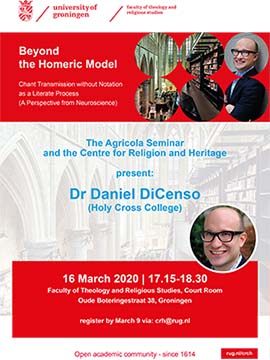Beyond the Homeric Model: Chant Transmission without Notation as a Literate Process (A Perspective from Neuroscience) | Cancelled
Due to the coronavirus this event has been postponed until further notice!
The Agricola Seminar and the Centre for Religion and Heritage present:
Dr Daniel DiCenso (Holy Cross College) will argue that Homer is not the best model for understanding how chant transmission may have worked. Sources surviving from the Carolingian era show that, unlike Homer, the transmission of chant involved the use of written texts alongside or as direct aids for the dissemination of melody by memory.
He will demonstrate how the earliest sources of chant for the mass could have succeeded in stimulating melodic recall by deploying diverse kinds of written memory cues.
Dr DiCenso will hypothesize how text cues in the earliest chant manuscripts may have used words without neumes to preserve melody with greater stability than previously thought possible.
Register by March 9 via: crh rug.nl

Most scholars agree that the body of liturgical song known as Gregorian chant owes its existence to the Carolingian liturgical reforms, which aimed to suppress local plainchant dialects in order to establish an authoritative and at least nominally “Roman” chant across the Frankish empire. Though notated sources confirm that a Gregorian norm had been established by the tenth century, how a uniform repertory could have been disseminated before the age of notated music books (during the Carolingian era) remains a heated debate. The theory favoured by most scholars, however, suggests that chant may have been disseminated like Homer’s texts in the ancient world—that is, orally rather than in writing.
Though the Homeric model has been enormously valuable in drawing scholarly attention to the role memory may have played in the dissemination of chant, Dr DiCenso will argue that Homer is not the best model for understanding how chant transmission may have worked. Sources surviving from the Carolingian era show that, unlike Homer, the transmission of chant involved the use of written texts alongside or as direct aids for the dissemination of melody by memory. He aims to demonstrate how the earliest sources of chant for the mass could have succeeded in stimulating melodic recall by deploying diverse kinds of written memory cues. Contemporary studies in neuroscience have shown how text cues are able to evoke memory of melody with astonishing accuracy by exploiting the fact that song texts (lyrics) are stored in the brain differently from ordinary, non-musical texts.
beyond the oral/written debate
Dr DiCenso will hypothesize how text cues in the earliest chant manuscripts may have used words without neumes to preserve melody with greater stability than previously thought possible. Where once the emergence of graphic notation was regarded as a game-changer (marking a shift from “pre-literate” to “literate” musical transmission), DiCenso moves beyond the oral/written debate and will show how text alone could have achieved many of the same stabilizing functions as the earliest forms of musical notation. Thus, the history of musical literacy (the history of written transmission) can be said to begin not with neumes in the ninth century, but with different kinds of text cues found in chant books much earlier, no later than the end of the eighth century.

